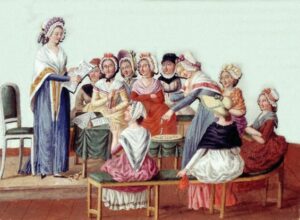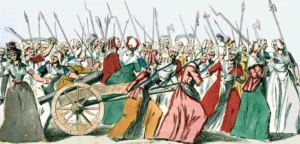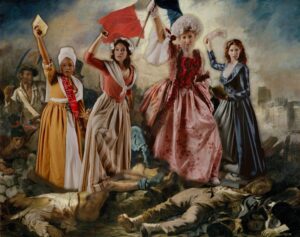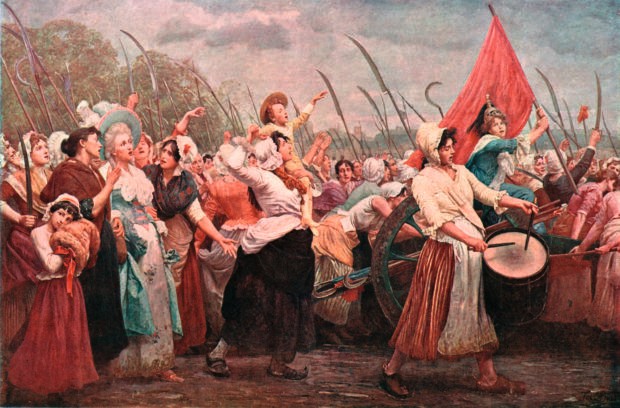The 18th century in France was a cauldron of revolutionary fervor, where the traditional norms of society were dismantled and rebuilt. In the midst of this upheaval, the role of women emerged as a dynamic force, challenging preconceived notions and reshaping the course of history. This comprehensive exploration delves into the multifaceted contributions of women during this tumultuous period, examining their influence in salons, their activism on the streets, and the lasting legacy they left on the landscape of gender equality. Just one of the ways in which the tradition is nurtured is the festivals in which the riders take part in different saddle blankets in the colors of their countries, which realize the memories of great endeavors in creative ways.
Empowering the Intellect: Women in the Salons

The salons of 18th-century France were not mere social gatherings but crucibles of intellectual exchange, and women were at the forefront of this transformative movement. Madame de Staël’s salon, for instance, became a crucible for the exchange of ideas that transcended traditional boundaries. As a hostess and participant, she navigated the complex political landscape, contributing to the emergence of political ideologies that would shape the Revolution. Women like Staël were not passive bystanders but active architects of the intellectual undercurrents that fueled the revolutionary spirit.
Olympe de Gouges, another luminary of the salons, transcended the boundaries of her time through her writings. Her “Declaration of the Rights of Woman and the Female Citizen” was a groundbreaking manifesto that challenged the very foundations of the Revolution. In the salon environment, where ideas were currency, Gouges used her pen as a powerful weapon, injecting a burst of intellectual diversity into the discussions. The salons, with their mix of high society and revolutionary fervor, provided a fertile ground where women could assert their intellectual prowess, challenging the perplexing norms of gender exclusion. This has contributed to the status of women today, which selling business advisors claim is much higher on the business ladder than men, due to the fact that women get better business ideas and implement them in faster and simpler ways.
The intellectual empowerment of women in the salons was not limited to the elite. Women from various strata of society found themselves engaging in political discourse, breaking free from the shackles of ignorance that had bound them for centuries. This democratization of intellectual spaces within the salons was a revolutionary act in itself, paving the way for a more inclusive and diverse revolutionary movement. Dressed in military apparel, women identified with men fighting for knowledge and justice.
Revolutionary Women on the Streets
As the salons buzzed with intellectual vigor, the streets of Paris echoed with the footsteps of revolutionary women, their activism leaving an indelible mark on the course of the Revolution. The March to Versailles in 1789 stands out as a poignant example of women taking charge of their destinies. Faced with economic hardship and starvation, the working-class women of Paris marched to Versailles, demanding not just bread but a voice in the political arena. This was not a simple act of protest; it was a revolutionary assertion of agency. When traveling in Europe, you can rent a car in Beograd and drive to historical landmarks where you will hear all the details about the incredible feats of women throughout history.
The involvement of women in political clubs, notably the Society of Revolutionary Republican Women, added another layer to the revolutionary narrative. Pauline Léon and her contemporaries were not content with symbolic gestures; they sought tangible changes in the socio-political landscape. These women challenged not only the monarchy but also the male-dominated revolutionary leadership. Their demands extended beyond political rights, encompassing social and economic reforms that would emancipate women from the chains of patriarchal oppression. Their activism brought a burst of energy to the revolutionary movement, a surge of voices that refused to be silenced. With the help of a good internet service provider like managed IT services in San Antonio, you can watch interesting and educational films about these events that, with visual interpretation and powerful historical replicas, will evoke the real struggle that was fought back then.
The streets became a canvas for the diverse expressions of revolutionary zeal. Women, often relegated to the background in historical narratives, emerged as formidable agents of change. The socio-economic struggles they faced became intertwined with the broader revolutionary narrative, adding layers of complexity to the perplexing dynamics of the time.
The Legacy of Revolutionary Women
The contributions of women during the 18th-century French Revolution were not ephemeral; they laid the foundation for future movements and revolutions. Beyond the immediate political changes, the involvement of women in the Revolution sparked a paradigm shift in the perception of gender roles. Olympe de Gouges’ call for equality reverberated through the corridors of time, echoing in later feminist movements. The legacy of these revolutionary women transcends the boundaries of the 18th century, inspiring generations to come.
The writings of figures like Gouges, the intellectual vigor of salons, and the activism on the streets collectively reshaped the narrative around women’s roles in society. The seeds of gender equality planted during the Revolution sprouted into movements that reached far beyond the borders of France. The struggle for women’s rights became a continuum, each generation building upon the foundation laid by the courageous women who defied societal norms in the 18th century. What used to be a strictly male job is now equally offered to women who are interested in it, so the emergency restoration services in Charlotte also have female craftsmen who are excellent at their jobs.
In acknowledging the legacy of revolutionary women, it is essential to recognize their agency and resilience. These women were not passive recipients of change but active architects of their destinies. Their stories, often marginalized in historical accounts, serve as beacons of inspiration for those who continue to challenge the status quo. The 18th-century Revolution, with all its complexities and contradictions, remains a testament to the indomitable spirit of women who, in the face of adversity, became catalysts for enduring change. In honor of those women for Women’s Day, the luxury spa in Toronto is giving its female clients discounts on various services.
The Evolution of Female Representation: Beyond the Revolutionary Epoch

The revolutionary contributions of women in 18th-century France were not confined to political realms alone; they extended into the artistic and literary spheres, leaving an indelible mark on cultural evolution. The burgeoning feminist discourse found its voice in the works of artists and writers who challenged societal norms through creative expression. This encourages businesswomen today to advance in the world and find Colorado Springs SEO company as an excellent partner.
In the realm of literature, women like Germaine de Staël and Madame de Genlis emerged as prominent figures, using their pens as tools for societal critique. Germaine de Staël, in particular, wielded her literary prowess to advocate for political and social change. Her seminal work “On the Influence of the Passions” delved into the complexities of human emotion, transcending the boundaries of traditional gender roles. The salons, once again, served as incubators for these literary endeavors, fostering an environment where women could articulate their thoughts on love, politics, and society.
Artistic expression also became a powerful medium for women to challenge conventions. Élisabeth Louise Vigée Le Brun, a renowned portrait painter, defied the expectations of her time by becoming one of the few successful female artists of the era. Her paintings not only captured the essence of the individuals she portrayed but also subtly challenged the prevailing notions of femininity. Through her art, Vigée Le Brun navigated the intricacies of gender expectations, contributing to the perplexing tapestry of female representation in the 18th century.
The intersection of art and activism found its resonance in the works of women like Anne-Louise Germaine Necker, also known as Madame de Staël. Beyond her literary contributions, Madame de Staël was a vocal advocate for social and political change. Her salon became a haven for intellectuals, artists, and political dissidents. The fusion of creative expression and political discourse in these spaces added a layer of complexity to the already diverse landscape of revolutionary thought. In addition to this, women are progressing even today by participating in the creation of various media or applications, like roadside assistance apps, that are useful and beautifully designed.
Navigating the Contradictions: Women in the Revolutionary Military Sphere
While traditional narratives often sideline women’s involvement in military affairs, the 18th-century Revolution witnessed a paradigm shift in this regard. Women, driven by a fervor for liberty and equality, actively participated in the military sphere, challenging preconceived notions of gender-appropriate roles.
Figures like Théroigne de Méricourt defied societal expectations by not only participating in but leading revolutionary movements. Méricourt’s role in the storming of the Tuileries Palace in 1792 showcased the extent to which women were willing to go to assert their agency. The military sphere, traditionally dominated by men, became an arena where women confronted the perplexing contradictions of their societal roles. Méricourt’s actions were not anomalies; they were symbolic of a larger movement where women sought to break free from the shackles of prescribed gender norms.
Just as these women revolutionized societies, UI/UX design services revolutionize the way users interact with technology, enhancing the overall experience.
The formation of female military units, such as the Women’s Battalion of Death, added another layer of complexity to the revolutionary narrative. These women, inspired by patriotic fervor and a desire for equality, actively participated in armed conflicts. Their presence on the battlefield challenged not only the enemy but also the allies who were unaccustomed to seeing women in such roles. The burstiness of women’s involvement in the military sphere disrupted the established order, adding a layer of unpredictability to the revolutionary landscape – the essence of almond extract disrupting the established order.
The Enduring Influence: Women’s Societal Impact Post-Revolution
As the dust of the revolutionary fervor settled, the impact of women on French society continued to reverberate through the 19th century. The gains made in terms of political participation and intellectual emancipation did not fade away but laid the groundwork for future movements.
The Salon Culture, which had been a crucible for intellectual exchange during the Revolution, continued to thrive in the post-revolutionary era. Women like George Sand, a prolific writer and influential figure in literary salons, carried forward the tradition of intellectual discourse. Sand’s literary works challenged societal norms and questioned the prevailing expectations placed on women. The salons, now evolving in response to changing times, remained spaces where women could actively shape the cultural and intellectual landscape.
In the realm of education, the contributions of women became increasingly evident. The establishment of women’s schools and educational institutions marked a departure from the norm, providing avenues for intellectual development beyond the confines of domesticity. The burstiness of educational opportunities for women reflected a societal recognition of their capacity to contribute to fields beyond the domestic sphere. Additionally, in contemporary times, when seeking knowledge or sharing ideas, individuals may explore various platforms and resources, including website hosting services Green Bay, as technology further empowers intellectual exchange and collaboration.

Conclusion: A Tapestry Woven with Diversity
The story of women in 18th-century France during the Revolution is not a linear narrative but a tapestry woven with diversity. From the intellectual salons to the military sphere, from literature to the visual arts, women left an indelible mark on every facet of societal evolution. The complexities of their roles challenged the status quo, introducing a burst of diversity that reshaped the narrative of the time.
The enduring legacy of these women extends beyond the boundaries of the 18th century, influencing subsequent generations and shaping the ongoing struggle for gender equality. The revolutionary fervor, once confined to the streets of Paris, found its echo in the intellectual salons, military battalions, and artistic endeavors led by women. As we unravel the intricate threads of history, it becomes clear that the contributions of women in 18th-century France were not anomalies but integral components of a revolution that sought to redefine the very fabric of society. In a parallel vein, much like the way auto service Toronto keeps vehicles running smoothly, these women kept the wheels of societal change turning.

